You may shrug off a nagging cough or shortness of breath as nothing serious. Millions of people in the United States live with COPD and other lung disease without knowing it. Noticing small changes in breathing can lead to earlier detection and better outcomes.
Early detection gives you choices: clearer diagnosis, targeted treatment, and a better chance to protect your long-term lung health. Simple symptoms that seem minor now can signal conditions like COPD, asthma, or lung cancer.
Taking time to track what you feel and speaking up with your care team can save you trouble later. Acting soon can protect your life and preserve the activities you love.
Key Takeaways
- Small breathing changes can mean serious problems; notice and act.
- Early detection improves treatment options and outcomes.
- Millions have undiagnosed COPD—don’t assume symptoms are just age.
- A prompt visit can prevent a decline in lung health and quality of life.
- The American Lung Association stresses taking symptoms seriously and seeking evaluation.
Why Paying Attention to Your Breathing Today Protects Your Life
Catching subtle breathing changes now helps you keep more control over your future health. Most lung diseases don’t have a quick fix, but timely action can slow decline and protect what matters to you.
Early detection gives your provider more treatment choices. When you report new shortness breath, an unexplained cough, or a change in your breath, your provider can act before serious loss of lung function occurs.
Early detection can prevent serious loss of lung function
Detecting problems early means more options to keep you active and independent. Working with a trusted provider helps you set realistic goals for your quality life and tailor medications or therapies.
When mild symptoms aren’t “just aging”
People often blame age for getting winded faster. Track triggers, duration, and relief. That data helps your healthcare provider personalize care and reduce avoidable setbacks that interrupt your life.
- Act early: Treat changes as a signal, not a phase to ignore.
- Partner with your provider: Create a plan you can follow without guesswork.
- Track details: Symptom logs help detection and better outcomes.
| What to watch | Why it matters | What your provider can do |
|---|---|---|
| New shortness breath | May signal worsening lung function | Assess, test, adjust treatment |
| Unexplained cough | Could indicate disease progression | Diagnose cause, start targeted care |
| Change in regular breath | Often precedes more severe symptoms | Personalize plan to preserve life quality |
Warning Signs of Lung Disease and Respiratory Problems
When a cough won’t quit or breathing feels heavier than usual, it’s time to pay attention.
Chronic cough that lasts eight weeks or longer often signals an underlying lung disease. Even a mild, steady cough needs evaluation to rule out persistent infection, chronic bronchitis, or other diseases.
Shortness at rest or after minimal exertion is not normal. If routine tasks leave you short or your breath feels labored, tell your provider right away.
Daily mucus or phlegm for a month or more points to ongoing airway irritation. Note color, amount, and timing to help diagnosis.
Wheezing or noisy breathing suggests narrowed airways. Coughing up blood always deserves urgent attention, even if it’s a small amount.

- Persistent chest pain that worsens with deep breaths or coughing needs prompt review.
- Pairs or clusters of symptoms strengthen the case for testing and early care.
- Log dates, triggers, and changes to make visits more effective.
| Symptom | What it may mean | When to see a provider | Helpful detail to report |
|---|---|---|---|
| Chronic cough | Chronic bronchitis, infection, or other disease | After 8 weeks | Duration, time of day, sputum |
| Shortness of breath | Reduced lung function or cardiac overlap | With rest or minimal exertion | Activity level, onset, severity |
| Coughing blood / chest pain | Potential bleeding, inflammation, or tumor | Immediately | Amount of blood, pain pattern |
For more detail on early warning signs, see this resource or review updated guidance at this summary.
Who’s at Risk: Common Causes and Conditions Behind These Symptoms
Many different causes can hide behind new breathing changes, and knowing them helps you act fast. COPD affects more than 16 million Americans, with many more undiagnosed. Early diagnosis may prevent further loss of function.
Asthma, COPD, and chronic bronchitis/emphysema
Asthma and chronic obstructive pulmonary conditions often explain ongoing cough, wheeze, or shortness breath. Anyone can develop COPD, but risk rises after age 40 and with a smoking history.
Lung infections like pneumonia
Pneumonia and other infections can cause sudden fever, productive cough, and fatigue. If you recover slowly or get repeat infections, ask for further testing.
Lung cancer and pulmonary nodules
Lung cancer can appear subtly—persistent cough, chest pain, or blood in sputum may be clues. Pulmonary nodules are often found by scan and need follow-up.
Smoking, secondhand smoke, air pollution, and workplace exposures
Smoking greatly increases risk, but 1 in 4 people with COPD never smoked. Secondhand smoke, air pollution, and workplace dust or fumes are common causes you can address.
Genetic risks such as alpha-1 antitrypsin deficiency
Family history matters. Alpha-1 antitrypsin deficiency raises risk for emphysema; ask your provider whether testing fits your situation.

Don’t Wait: When to Contact Your Healthcare Provider and What to Expect
A prompt visit when symptoms shift gives your provider the best chance to find the cause early. If you notice new or worsening shortness at rest, a cough lasting eight weeks, chronic mucus for a month, wheeze, any blood in sputum, or chest pain with breathing, call your healthcare provider now.
Red flags that mean you should make an appointment now
- Chronic cough eight weeks or more.
- Shortness at rest or after minimal effort.
- Persistent phlegm for a month, wheeze, blood in sputum, or chest pain that worsens with breathing.
How to prepare: symptom logs, medication lists, and medical history
Bring your medical history, copies of recent records if possible, and a full medication list: prescriptions, over-the-counter drugs, vitamins, herbs, and supplements.
Keep a simple symptom log with start dates, triggers, and what helps. List other healthcare providers you see so your provider gets the full picture.
Diagnosis basics: spirometry and other lung function tests
Expect basic tests like spirometry. This measures how much and how fast you exhale and helps with a clear diagnosis and treatment plan.
“Ask your provider to explain results in plain language and offer a clear next step before you leave.”
| When to call | What to bring | What to expect |
|---|---|---|
| Cough ≥ 8 weeks, blood in sputum, new shortness | Medical history, full medication list, symptom log | Clinical exam, spirometry, possible imaging, follow-up plan |
| Wheezing or chest pain with breathing | List of other providers and recent test results | Assess lung function, rule out cardiac causes, start targeted care |
| Persistent mucus or repeat infections | Notes on triggers, timing, and what improves symptoms | Diagnosis confirmation, tailored treatment, scheduled follow-ups |
Treatment Paths and Everyday Steps to Improve Your Breathing and Quality of Life
Working closely with your provider gives you practical steps to protect breathing and preserve daily life. Most conditions have no quick cure, but early diagnosis of COPD and other disease can prevent loss of function. Partnering with your healthcare team improves choices and results.
Working with your provider to tailor treatments
Personalized care boosts adherence and outcomes. Ask your provider to map a plan that fits your goals and routine. That plan can include medicines, devices, pulmonary rehab, vaccines, and lifestyle changes.
Managing triggers at home, work, and outdoors
- Identify triggers: smoke, dust, fumes, strong odors, temperature swings, and seasonal pollution.
- Daily habits: take treatment as prescribed, stay active within limits, keep vaccines current, and practice airway clearance if advised.
- Air quality: improve ventilation, fix moisture to prevent mold, and consider HEPA filtration where exposure is high.
- Track and adjust: keep a symptom diary and review it with your healthcare provider after flares or hospital stays.
“When you and your provider act early, you often prevent bigger setbacks.”
Build support—family, friends, and your healthcare team help with refills, appointments, and motivation so you can protect lung health and keep a better quality life. Learn more about trigger management here.
Conclusion
If you notice steady changes in how you breathe, act now—small steps today can protect your future health.
COPD is common and often undiagnosed, but early diagnosis and treatment can slow loss of lung function and help you stay active. Lung cancer, pneumonia, and other infections may start with mild symptoms; don’t let them go unchecked.
Bring your notes, medication list, and recent records to your appointment. That information speeds diagnosis and helps your provider map clear, practical treatments.
Take action: schedule a visit for ongoing cough, breath changes, chest discomfort, or any blood in sputum. Stay engaged after the visit—follow the plan, reduce exposures, and use community resources so your lungs keep working for the life you want.



